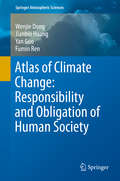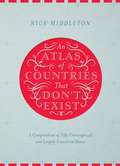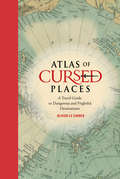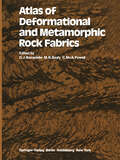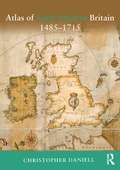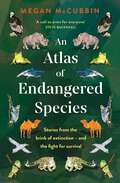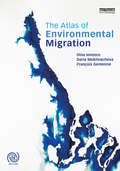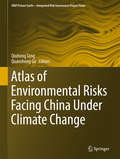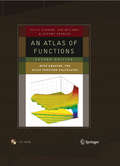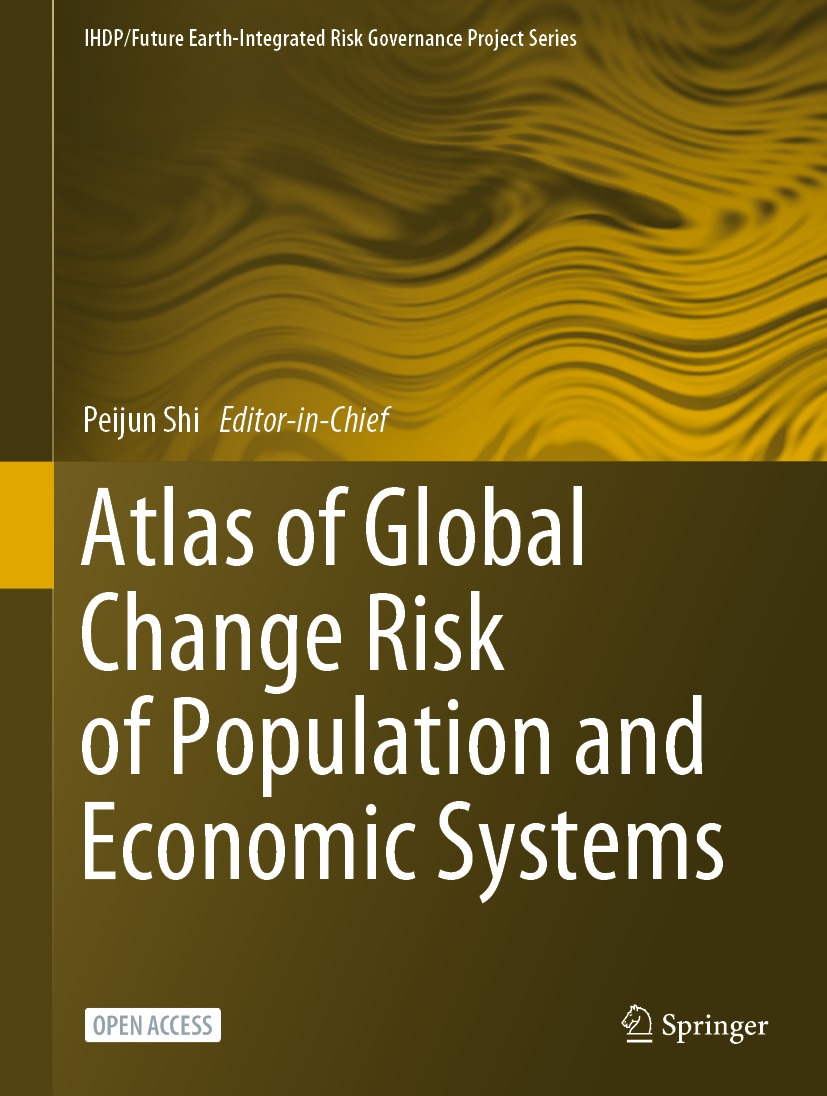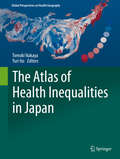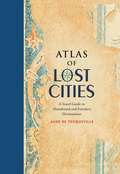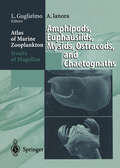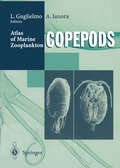- Table View
- List View
The Atlas of Climate Change: Super-Ensemble Projection and Attribution (SEAP) of Climate Change (Springer Earth System Sciences)
by Wenjie Dong Fumin Ren Jianbin Huang Yan Guo"The Atlas of Climate Change—Based on SEAP-CMIP5" is intended to satisfy readers’ curiosity: how will our climate system change over the next 100 years? It is the first showcase for the state-of -the-art earth system models that released their CMIP5 simulations for the IPCC AR5.The atlas focuses on both the past climate system change from 1850 and the projection of the future climate system change to 2100 using the RCP2.6, RCP4.5 and RCP8.5 scenarios based on climate models. This provides the research and application community interested in the impact of climate change on fields such as agriculture, ecosystem, environment,water resources, energy, health, economy, risk governance and international negotiation, etc. with the newest climate change projection information. Additionally, the atlas will show the historical responsibility of the developed/developing countries and possible contributions to the mitigation of climate change according to their pledge of GHG emission reduction after the Cancun Agreement as an extension numerical experiment to CMIP5 with NCAR’s CESM1.0. The authors will update this atlas after future releases of CMIP5 model outputs and update the figures in the second edition of the atlas in 2012-2013. Both Prof. Wenjie Dong and Yan Guo work at the Beijing Normal University, China. Prof. Fumin Ren works at the China Meteorological Administration, China. Prof. Jianbin Huang works at the Tsinghua University, China.
Atlas of Climate Change: Responsibility and Obligation of Human Society (Springer Atmospheric Sciences)
by Wenjie Dong Jianbin Huang Yan Guo Fumin RenThis atlas and reference resource assembles the latest research findings on the responsibility and obligation of human society for historical climate change. It clearly and quantitatively estimates to what extent the developed and developing world are responsible for historical climate change with regard to anthropogenic carbon and sulfur emissions as well as global carbon trade, and so provides a potential tool to address the controversial issue of carbon emission reduction in international climate negotiations. Since the quantitative attribution of historical climate change is calculated based on CMIP5 models, the fidelity of these models in representing the observed climate change is also evaluated. In addition to evaluation, future climate change based on CMIP5 models is also shown both on global and regional scales (especially for China and its surrounding areas ) in terms of surface air temperature, precipitation, sea surface temperature, atmospheric circulations and Arctic Sea ice. The atlas also makes various comparisons among different multi-model ensemble methods in order to obtain the most reliable estimation.
An Atlas of Countries That Don't Exist: A Compendium of Fifty Unrecognized and Largely Unnoticed States
by Nick MiddletonAcclaimed travel writer and Oxford geography don Nick Middleton takes us on a magical tour of countries that, lacking diplomatic recognition or UN membership, inhabit a world of shifting borders, visionary leaders and forgotten peoples.Most of us think we know what a country is, but in truth the concept is rather slippery. From Catalonia to the Crimea, and from Africa's last colony to the European republic that enjoyed just a solitary day of independence, the places in this book may lie on the margins of legitimacy, but all can be visited in the real world.Beautifully illustrated by fifty regional maps, each shadowy country is literally cut out of the page of this book. Alongside stories, facts and figures, An Atlas of Countries That Don't Exist brings to life a dreamlike world of nations that exist only in the minds of the people who live there.
Atlas of Cursed Places: A Travel Guide to Dangerous and Frightful Destinations
by Olivier Le CarrerAtlas Obscura says this lushly illustrated New York Times bestselling guide to dozens of dangerous, eerie, and infamous locations is the perfect gift for "those who believe the world is still full of mysteries to investigate."Pick up the acclaimed Atlas of Cursed Places and visit the world's most nerve-wracking locations. With pithy historical profiles, vintage full-color maps, and haunting tales that will color your perspective (and send tingles down your spine), this is a clever gift for the intrepid traveler or armchair adventurer who wants to explore destinations both remarkable and daunting. Visit:a coal town where the ground is constantly on firea Zambian national park where more than 8 million bats darken the skiesthe infamous suicide location of Aokigahara Forest near Mount Fujithe lesser-known Nevada triangle, in which dozens of aircraft have inexplicably disappeared Beautifully packaged and written with a twisty sense of humor, Atlas of Cursed Places puts your quirky side on the map.
Atlas of Cursed Places: A Travel Guide to Dangerous and Frightful Destinations
by Olivier Le CarrerAtlas Obscura says this lushly illustrated New York Times bestselling guide to dozens of dangerous, eerie, and infamous locations is the perfect gift for "those who believe the world is still full of mysteries to investigate." Pick up the acclaimed Atlas of Cursed Places and visit the world's most nerve-wracking locations. With pithy historical profiles, vintage full-color maps, and haunting tales that will color your perspective (and send tingles down your spine), this is a clever gift for the intrepid traveler or armchair adventurer who wants to explore destinations both remarkable and daunting. Visit:a coal town where the ground is constantly on firea Zambian national park where more than 8 million bats darken the skiesthe infamous suicide location of Aokigahara Forest near Mount Fujithe lesser-known Nevada triangle, in which dozens of aircraft have inexplicably disappeared Beautifully packaged and written with a twisty sense of humor, Atlas of Cursed Places puts your quirky side on the map.
Atlas of Deformational and Metamorphic Rock Fabrics
by G. J. Borradaile M. B. Bayly C. McA PowellIn May 1976 Lucian B. Platt organized a highly successful Penrose Confer ence on The Formation of Rock Cleavage at Bryn Mawr College in Penn sylvania, U. S. A. The meeting drew together about 70 specialists from both sides of the Atlantic and from Australasia, who contributed discussions on various aspects of rock cleavage and its formation. Even early in the meet ing it became clear to the participants that they lacked a common terminol ogy, that often the same technical word implied different things to different people and that observables and descriptors were loosely defined. In an at tempt to improve communication the present editors contacted about 190 workers after the conference with a view to compiling a set of photographs with captions to illustrate exactly what workers were talking about. As a re sult the compilation was published as a limited edition by an inexpensive offset process at the University of Tasmania. The success of that provisional edition of the Atlas of Rock Cleavage and the responses of the readers prompted us to make a more extensive collection of material, contact a wider range of workers and, with the support of Dr. Konrad Springer, to publish the present higher-quality reproduction of the contributors' plates.
Atlas of Early Modern Britain, 1485-1715
by Christopher DaniellThe Atlas of Early Modern Britain presents a unique visual survey of British history from the end of the Wars of the Roses through to the accession of George I in 1715. Featuring 117 maps, accompanied throughout by straightforward commentary and analysis, the atlas begins with a geographical section embracing England, Scotland, Ireland and Wales and providing clear orientation for the reader. It then focuses separately on the sixteenth and seventeenth centuries, dividing its coverage of each into four key themes: Geography and Counties - Outlining in detail how Britain's geography was shaped during the period; Politics and War - the main campaigns, rebellions and political changes in each century; Religion - including denominational concentrations, diocesan boundaries and witch trials; Economy and Culture -charting Britain's wealthiest towns, the locations of Britain's houses of aristocracy and the effects of The Great Fire of London; The broad scope of the atlas combines essential longer-term political, social, cultural and economic developments as well as key events such as the Spanish Armada, the Dissolution of the Monasteries, the Civil War and the Glorious Revolution. Its blend of clear visual aids and concise analysis represents an indispensable background and reference resource for all students of the early modern period.
Atlas of Early Modern Britain, 1485-1715
by Christopher DaniellThe Atlas of Early Modern Britain presents a unique visual survey of British history from the end of the Wars of the Roses through to the accession of George I in 1715. Featuring 117 maps, accompanied throughout by straightforward commentary and analysis, the atlas begins with a geographical section embracing England, Scotland, Ireland and Wales and providing clear orientation for the reader. It then focuses separately on the sixteenth and seventeenth centuries, dividing its coverage of each into four key themes: Geography and Counties - Outlining in detail how Britain's geography was shaped during the period; Politics and War - the main campaigns, rebellions and political changes in each century; Religion - including denominational concentrations, diocesan boundaries and witch trials; Economy and Culture -charting Britain's wealthiest towns, the locations of Britain's houses of aristocracy and the effects of The Great Fire of London; The broad scope of the atlas combines essential longer-term political, social, cultural and economic developments as well as key events such as the Spanish Armada, the Dissolution of the Monasteries, the Civil War and the Glorious Revolution. Its blend of clear visual aids and concise analysis represents an indispensable background and reference resource for all students of the early modern period.
An Atlas of Endangered Species
by Megan McCubbin'A call to arms for everyone' Steve BackshallThe diversity of life on earth is astounding, with each species perfectly adapted to its environment. Sharks can navigate the ocean using electromagnetic fields; sloths use algae as camouflage; albatross can fly for hours without beating their wings; and orca pods each have unique cultures and languages. But every hour, three species disappear. Our incredible world is at risk.Megan McCubbin reveals the stories of the scientists, rangers and conservationists who are fighting to save these extraordinary creatures from extinction. An Atlas of Endangered Species shows us that the battle is on for their survival - and we all have a part to play.'Joyful and heartbreaking, an inspiring celebration of some of our planet's most endangered species and those who champion them' - Dave Goulson, author of Silent Earth'A powerful, passionate plea for a wilder future' - Sophie Pavelle, author of Forget Me Not
The Atlas of Environmental Migration
by Dina Ionesco Daria Mokhnacheva François GemenneAs climate change and extreme weather events increasingly threaten traditional landscapes and livelihoods of entire communities the need to study its impact on human migration and population displacement has never been greater. The Atlas of Environmental Migration is the first illustrated publication mapping this complex phenomenon. It clarifies terminology and concepts, draws a typology of migration related to environment and climate change, describes the multiple factors at play, explains the challenges, and highlights the opportunities related to this phenomenon. Through elaborate maps, diagrams, illustrations, case studies from all over the world based on the most updated international research findings, the Atlas guides the reader from the roots of environmental migration through to governance. In addition to the primary audience of students and scholars of environment studies, climate change, geography and migration it will also be of interest to researchers and students in politics, economics and international relations departments.
The Atlas of Environmental Migration
by Dina Ionesco Daria Mokhnacheva François GemenneAs climate change and extreme weather events increasingly threaten traditional landscapes and livelihoods of entire communities the need to study its impact on human migration and population displacement has never been greater. The Atlas of Environmental Migration is the first illustrated publication mapping this complex phenomenon. It clarifies terminology and concepts, draws a typology of migration related to environment and climate change, describes the multiple factors at play, explains the challenges, and highlights the opportunities related to this phenomenon. Through elaborate maps, diagrams, illustrations, case studies from all over the world based on the most updated international research findings, the Atlas guides the reader from the roots of environmental migration through to governance. In addition to the primary audience of students and scholars of environment studies, climate change, geography and migration it will also be of interest to researchers and students in politics, economics and international relations departments.
Atlas of Environmental Risks Facing China Under Climate Change (IHDP/Future Earth-Integrated Risk Governance Project Series)
by Qiuhong Tang Quansheng GeThis atlas provides the most comprehensive and accurate overview of environmental risks relating to climate change vulnerability and adaptation in China. It addresses the agricultural, ecosystem and heat wave health risk posed by climate change and presents the projected environmental risks in the 21st century under climate change and socioeconomic scenarios. The detailed and concise risk assessments are mapped in grid units, allowing easy environmental risk assessment for specific locations. The atlas contributes significantly to the knowledge base for climate change adaptation in China and is a valuable resource for students and professionals in the fields of geographic sciences and climate change.
Atlas of Fallen Dust in Kuwait
by Ali Al-DousariThis open access book serves as an atlas of deposited dust and dust storms in Kuwait in relation to local and global regions. It features a wealth of maps and images of dust storm trajectories in the region, together with detailed descriptions of the chemical and physical properties of fallen dust, including the amount, particle size, statistical parameters, spectra absorption, dust mineralogy, trace and major elements, organic matter, associated pollen, and radionuclides and connected pollutants. Given its scope, the book is a valuable resource for a broad range of researchers, including geologists, chemists, environmentalists, botanists, air quality specialists, nanotechnology scientists, and solar energy experts.
An Atlas of Functions: with Equator, the Atlas Function Calculator
by Keith B. Oldham Jerome Spanier Jan MylandThis book comprehensively covers several hundred functions or function families. In chapters that progress by degree of complexity, it starts with simple, integer-valued functions then moves on to polynomials, Bessel, hypergeometric and hundreds more.
Atlas of Global Change Risk of Population and Economic Systems (IHDP/Future Earth-Integrated Risk Governance Project Series)
by Peijun ShiThis book is open access and illustrates the spatial distribution of the global change risk of population and economic systems with the maps of environment, global climate change, global population and economic systems, and global change risk. The risks of global change are mapped at 0.25 degree grid unit. The risk results and their contribution rates of the world at national level are unprecedentedly derived and ranked. The book can be a good reference for researchers and students in the field of global climate change and natural disaster risk management, as well as risk managers and enterpriser to understand the global change risk of population and economic systems.
The Atlas of Health Inequalities in Japan (Global Perspectives on Health Geography)
by Tomoki Nakaya Yuri ItoThis new health atlas of Japan presents a series of maps about the health of the contemporary Japanese population, i.e. detailed maps of health indicators in small areas using cartograms. This is the first comprehensive small-area based health atlas about contemporary Japan using vital statistics from 1995-2014. Each map is supplemented with concise explanations written by leading epidemiologists and health geographers in Japan. The book employs various cutting-edge methods in spatial epidemiology, Bayesian spatial smoothing for the reliable mapping of mortality indices, advanced cartographic transformations using the concept of aerial cartograms, and summary statistics of socioeconomic health inequalities. The atlas highlights geographical aspects of social gradients in health by comparing mortality maps with distribution of deprivation index during the recent long-lasting economic stagnation period of Japan known as the lost decades. This health atlas will be a useful resource for international comparisons between Japan and other advanced countries in terms of health and related socioeconomic disparities between regions. It will be of interest to public health practitioners, administrators, researchers and students working on health geography and public health.
Atlas of Imagined Places: From Lilliput To Gotham City (Atlases Of The Imagination Ser. #01)
by Matt Brown and Rhys B. DaviesAtlas of Industrializing Britain, 1780-1914
by John Langton R.J. MorrisFirst published in 1986. Routledge is an imprint of Taylor & Francis, an informa company.
Atlas of Industrializing Britain, 1780-1914
by John Langton R.J. MorrisFirst published in 1986. Routledge is an imprint of Taylor & Francis, an informa company.
Atlas of Karst Collapses (Advances in Karst Science)
by Wanfang Zhou Mingtang Lei Xiaozhen Jiang Jianling Dai Meng YanThis book comprehensively documents the various types of karst collapse and related conceptual site models, before discussing these collapses in terms of their impacts on engineering and the environment. Featuring over 200 real-world photos to illustrate the variety of karst collapses and their consequences, the book also provides specific methods and techniques to prevent, investigate, monitor and remediate these collapses. Decades of experience with these collapses make it clear that addressing the related hazards requires a multi-disciplinary approach that integrates geomorphology, engineering geology, hydrology, hydrogeology, biology, geophysics, geochemistry, and risk assessment.
Atlas of Lost Cities: A Travel Guide to Abandoned and Forsaken Destinations
by Aude de TocquevilleExplore more than forty forsaken urban destinations around the world in a "highly entertaining read . . . for history buffs, mystery fanatics and travel junkies alike" (GoNomad). Cities are mortal, but the traces they leave behind tell a fascinating story. In Atlas of Lost Cities, an accomplished travel writer reveals the rise and fall of notable places, each pithy portrait illuminated by a vintage map that puts armchair explorers right in the scene. Wander with care through: Ancient and legendary places like Pompeii, Teotihuacá and AngkorContemporary wonders like Centralia, a nearly abandoned Pennsylvania town consumed by unquenchable underground fireEerie planned communities like Nova Citas de Kilamba in Angola, where housing, schools, and stores were built for 500,000 people who never cameEpecuen, a tourist town in Argentina that was swallowed by water With each map are fantastical illustrations that help the reader envision these hubs as they were in their prime. A perfect gift for the traveler who believes he or she has seen it all.
Atlas of Marine Zooplankton Straits of Magellan: Amphipods, Euphausiids, Mysids, Ostracods, and Chaetognaths
by T. Antezana G. Benassi G. Costanzo N. Crescenti I. Ferrari E. Ghirardelli A. Granata L. Guglielmo K. G. McKenzieAtlas of Marine Zooplankton Straits of Magellan: Copepods
by M. G. Mazzocchi G. Zagami Adrianna Ianora L. Guglielmo N. Crescenti J. HureThe Antarctic represents the last of the world's still unexplored continents. Since 1985, Italy has sent nine expeditions to this region, making it one of the most scientifically active nations in the Antarctic. Italy has built a permanent base there and has begun a systematic collection of data and samples which will contribute to our understanding of this peculiar and extremely fascinating continent. Within this framework, Italy has also conducted research in a sub-Antarctic region of great scientific interest, the Straits of Magellan. This region, with its characteristic oceanography and biota, represents a transition point between the faunal assemblages of temperate and antarctic seas. This atlas on the zooplankton is an important contribution to the study of the faunal assemblages of the region of the Straits and will hopefully be followed by others. The initiative is part of a vast program launched by the Italian Ministry of Universities and Scientific and Technological Research to promote the exploration of Antarctic and sub-Antarctic seas, the aim of which is to preserve one of the Earth's largest and most undisturbed natural laboratories.
An Atlas of Middle Eastern Affairs
by Ewan W. Anderson Liam D. AndersonThis revised and updated version of An Atlas of Middle Eastern Affairs provides accessible, concisely written entries on the most important current issues in the Middle East, combining maps with their geopolitical background. Offering a clear context for analysis of key concerns, it includes background topics, the position of the Middle East in the world and profiles of the constituent countries. Features include: Clearly and thematically organised sections covering the continuing importance of the Middle East, the background, fundamental concerns, the states and the crucial issues related to the area. Original maps integrated into the text, placing international issues and conflicts in their geographical contexts. Case studies and detailed analysis of each country, complete with relevant statistics and key facts. Coverage of fundamental considerations, such as: water shortage the petroleum industry conflicts and boundary issues A comprehensive further reading section, enabling students to cover the topic in more depth. Updated to include recent developments such as the "Arab Spring," this book is a valuable introduction to undergraduate students of political science and Middle East studies and is designed as a primary teaching aid for courses related to the Middle East in the areas of politics, history, geography, economics and military studies. This book is also an outstanding reference source for libraries and anyone interested in these fields.

